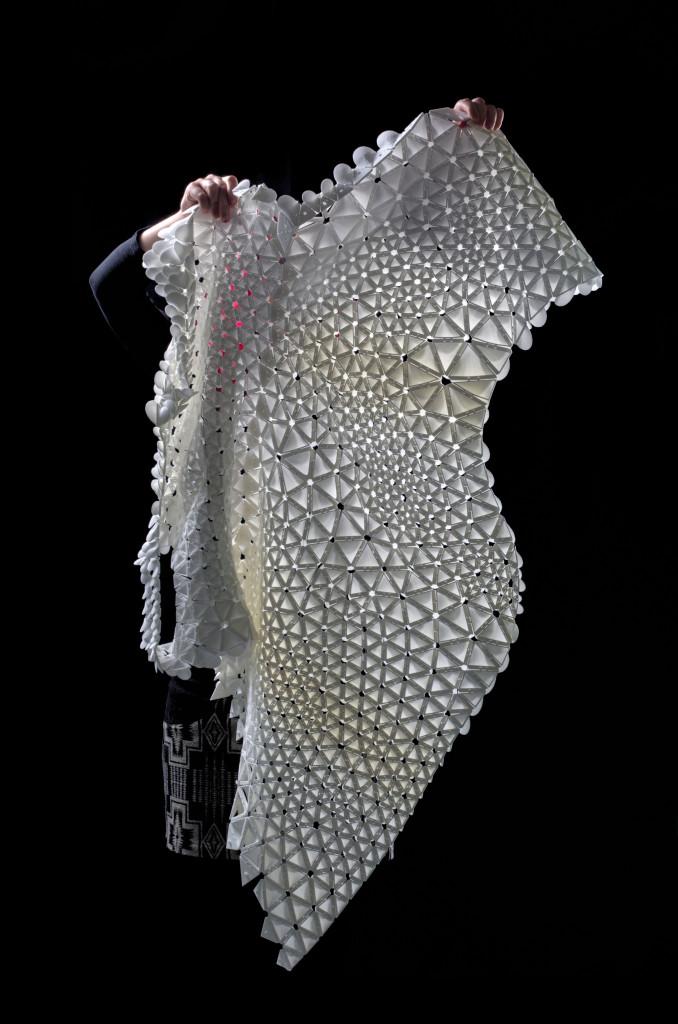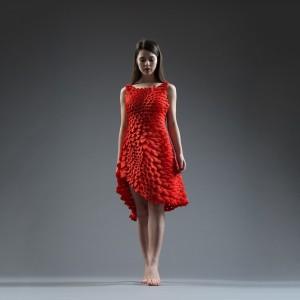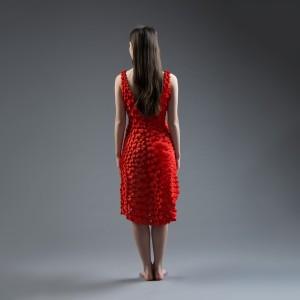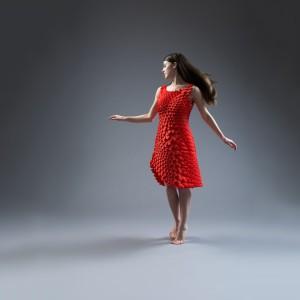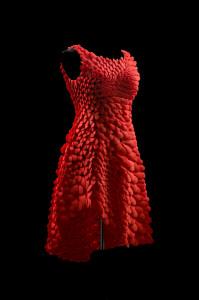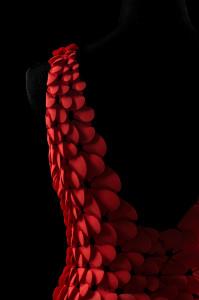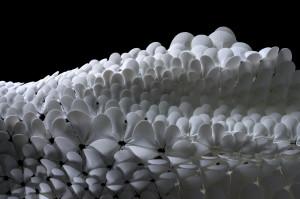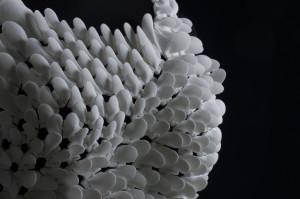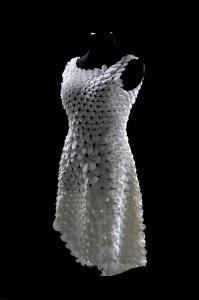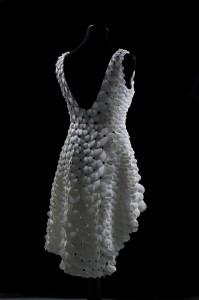 3D printed fashion seems to be everywhere these days. There certainly were a number of 3D printed dresses shown recently during New York Fashion Week. Now Nervous System, the design group that created the first Kinematics Dress in 2014, is at it again. Like the original Kinematics Dress, the Kinematics Petal Dress is printed in a single piece by Shapeways in SLS nylon.
3D printed fashion seems to be everywhere these days. There certainly were a number of 3D printed dresses shown recently during New York Fashion Week. Now Nervous System, the design group that created the first Kinematics Dress in 2014, is at it again. Like the original Kinematics Dress, the Kinematics Petal Dress is printed in a single piece by Shapeways in SLS nylon.
Nervous Systems’ Kinematics Dress is in the permanent collection at MOMA in New York. I saw it there and saw another version of it at the Shapeways office. It’s one thing to see it in pictures, but an entirely different experience seeing it in person and well worth the trip. For their latest project, Nervous System was commissioned to create a new dress for the Boston Museum of Fine Arts show, which features the works of fashion designers Iris van Herpen and Alexander McQueen, and Neri Oxman of MIT Media Lab. Designer Jessica Rosenkrantz, of Nervous System, is also a lecturer at MIT and for her latest creation she wanted to create a dress that while based on the hinged triangles of the Kinematics Dress, is more substantial.
In a recent interview with The Creators Project, Rosenkrantz described her approach to making the Kinematics Petal Dress:
“For the latest dress, we wanted to take it a step further and make it possible to also individually sculpt each of the interlocking panels in 3D,” says Rosenkrantz, “After the wearer is fully body scanned, her measurements are adapted to the Kinematic Dress‘s design. Our original dress was essentially like a digital lace (more or less see through) and now we’ve taken the same structure and covered it in an armor of parametric petals.”
Rosenkrantz has been experimenting with other parametric designs such as her Floraform jewelry, which is based on the biomechanical properties of differential growth. And whereas Floraform is rigid, the Kinematics Petal Dress moves as fluidly as the original Kinematics Dress, which is to say it moves like a traditional textile. It is also printed in one piece and can be worn fresh out of the printer (although the red dye is a post production process). Indeed, the Kinematics Petal Dress is not just runway fashion or a sculptural art piece, but clothing to be worn. Still, the design is not for the mass market, you’d have to be pretty well-heeled to afford it. The dress is priced in the thousands of dollars (each dress is custom made for the wearer).
As Rosenkrantz explains, “We’re trying to make real clothes, not science fiction. And we want to do that in a way that takes advantage of what 3D printing is really capable of. On the other hand though, our garments are still not realistic. The part our project that is most likely to be adopted and is really most essential is the incorporation of body scans and easy to use design apps that engage people in the process of making their own clothes. That’s where the technology really becomes indistinguishable from magic. Our dress has always been about customization.”
Like the other Kinematics dresses, the flexibility of the garment can be varied, so that certain sections are more rigid than others. This is achieved through a complex algorithm developed by Nervous System. They also use an algorithm to fold the dress for printing, so that it fits within Stratasys’ Fortus printer that Shapeways uses to print the dress in their Strong and Flexible Material (Nylon). This is why the Kinematics Dress and Kinematics Petal Dress are called 4D printed dresses. The complete dress is printed folded, in one piece and after it is removed, it can be unfolded into its final shape. Thus, the 3D printed dress changes over time, time being the 4th dimension.
Nervous System continues to push the boundaries of what is possible in generative fashion and jewelry design. It’ll be fascinating to see what they invent next.
Below is an additional video and images of the Kinematics Dress:
- Closeup of Kinematics petals.
- The dress after being dyed red.
- Closeup of Kinematics petals.
- Closeup of Kinematics petals.
- Closeup of Kinematics petals.
- Kinematics Petal Dress in SLS nylon before dyeing.
- Kinematics Petal Dress in SLS nylon before dyeing.
Subscribe to Our Email Newsletter
Stay up-to-date on all the latest news from the 3D printing industry and receive information and offers from third party vendors.
You May Also Like
Profiling a Construction 3D Printing Pioneer: US Army Corps of Engineers’ Megan Kreiger
The world of construction 3D printing is still so new that the true experts can probably be counted on two hands. Among them is Megan Kreiger, Portfolio Manager of Additive...
US Army Corps of Engineers Taps Lincoln Electric & Eaton for Largest 3D Printed US Civil Works Part
The Soo Locks sit on the US-Canadian border, enabling maritime travel between Lake Superior and Lake Huron, from which ships can reach the rest of the Great Lakes. Crafts carrying...
Construction 3D Printing CEO Reflects on Being Female in Construction
Natalie Wadley, CEO of ChangeMaker3D, could hear the words of her daughter sitting next to her resounding in her head. “Mum, MUM, you’ve won!” Wadley had just won the prestigious...
1Print to Commercialize 3D Printed Coastal Resilience Solutions
1Print, a company that specializes in deploying additive construction (AC) for infrastructure projects, has entered an agreement with the University of Miami (UM) to accelerate commercialization of the SEAHIVE shoreline...


